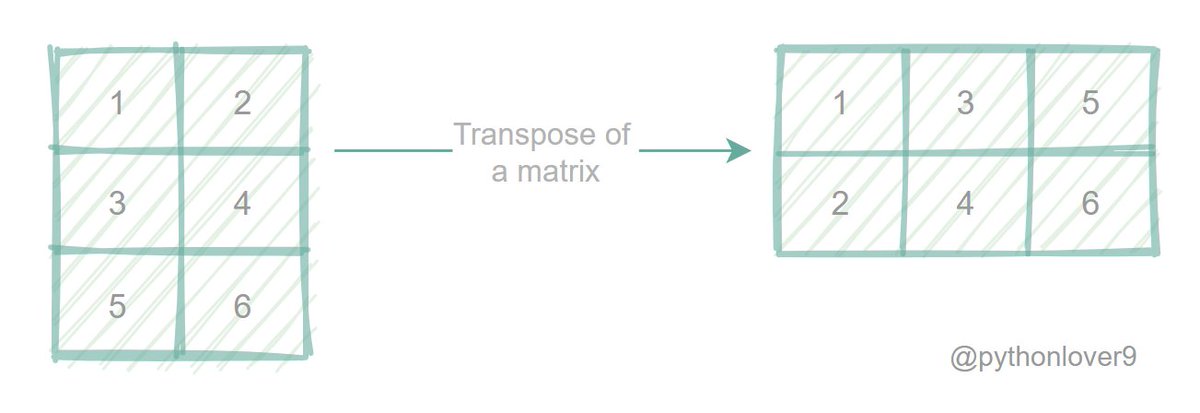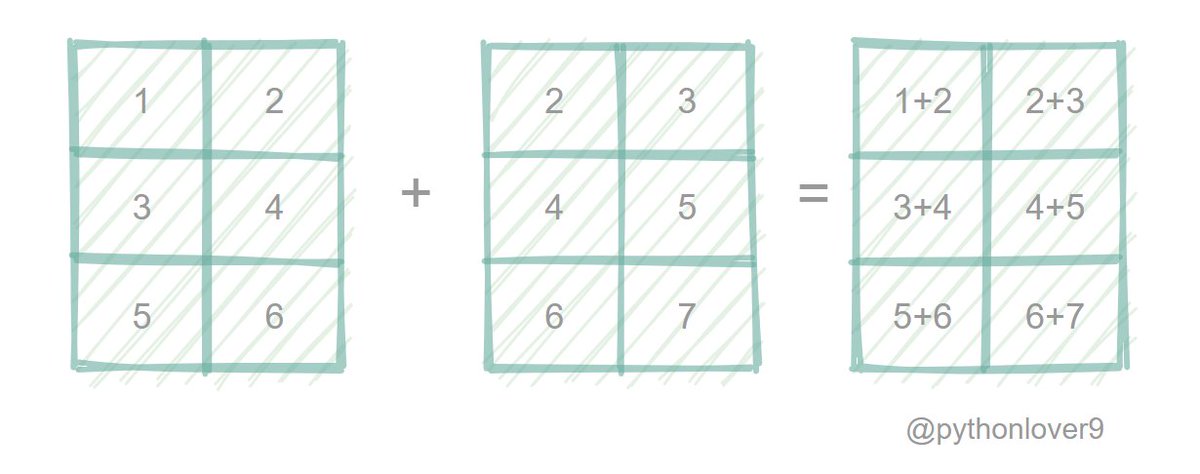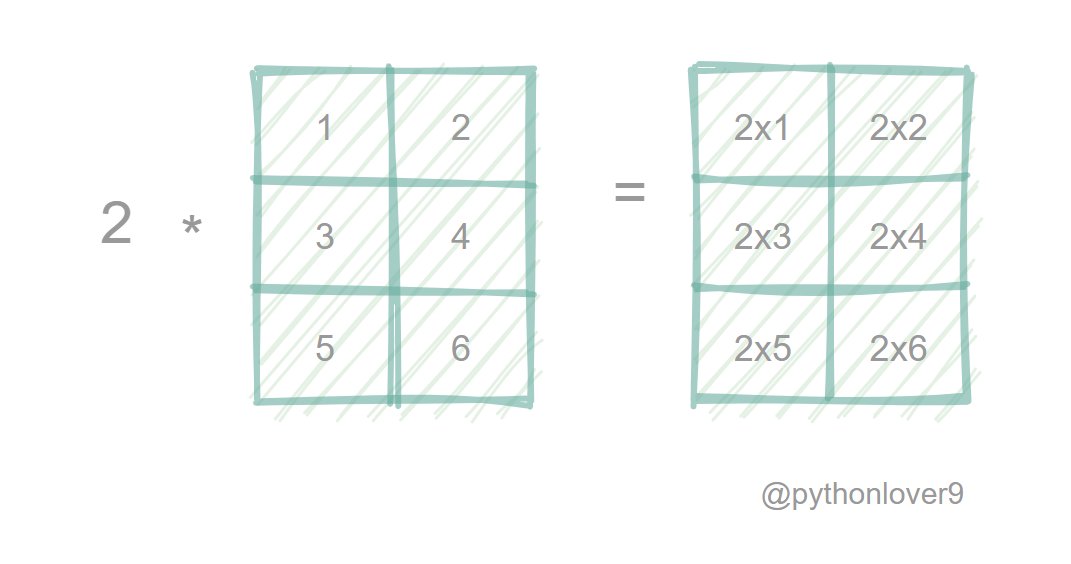The second lecture on Mathematics for Machine Learning.
In the first lecture, we discuss Matrix and its types.
In this, we will discuss Matrix operations and their properties.
#MathsForML #MachineLearning
In the first lecture, we discuss Matrix and its types.
In this, we will discuss Matrix operations and their properties.
#MathsForML #MachineLearning
1) Starting with Transpose of a matrix. Transpose is obtained by interchanging the rows and columns i.e. the first row will become the first column and so on.
2) Taking transpose of a transpose will give back the original matrix.
2) Taking transpose of a transpose will give back the original matrix.
3) Adding two matrices is nothing but adding corresponding elements of matrices.
Hence, we can only add two matrices having the same order.
4) Additive Identity of a matrix is a null matrix of the same order i.e. Summing A and O will result in A again.
Hence, we can only add two matrices having the same order.
4) Additive Identity of a matrix is a null matrix of the same order i.e. Summing A and O will result in A again.
5) Multiplying a matrix with a constant is basically multiplying each element of a matrix with that number. For example, -A is basically multiplying each element of A with -1.
6) -A is also the additive inverse of a matrix A i.e. Summing A and -A will equal to a null matrix.
6) -A is also the additive inverse of a matrix A i.e. Summing A and -A will equal to a null matrix.
7) Multiplying 2 matrices is slightly different.
8) Make sure that the number of columns in A is equal to the number of rows in B.
9) Resulting matrix will have the number of rows as A and the number of columns as B. If A is "mxn" and B is "nxr" then the product will be "mxr"
8) Make sure that the number of columns in A is equal to the number of rows in B.
9) Resulting matrix will have the number of rows as A and the number of columns as B. If A is "mxn" and B is "nxr" then the product will be "mxr"
10) Things to remember if AB is defined not necessarily BA is defined i.e. multiplication is not commutative.
11) Notice that for a square matrix of the same size both AB and BA are defined.
12) Although multiplication is associative whenever both are defined i.e. (AB)C = A(BC)
11) Notice that for a square matrix of the same size both AB and BA are defined.
12) Although multiplication is associative whenever both are defined i.e. (AB)C = A(BC)
13) k(AB) = (kA)B = A(kB) where k is a constant
14) Multiplicative Identity of a square matrix A of size n is the Identity matrix of the same size i.e. AIn = InA = A
15) A(B+C) = AB + AC i.e. Distribution over addition and subtraction.
14) Multiplicative Identity of a square matrix A of size n is the Identity matrix of the same size i.e. AIn = InA = A
15) A(B+C) = AB + AC i.e. Distribution over addition and subtraction.
Important
16) ( A+B )transpose equals to At+Bt
17) (AB)t equals to BtAt
18) Symmetric matrix if A transpose equals to A
19) Skew Symmetric matrix if A transpose equals to -A
20) If the product of A and its transpose is an Identity matrix then A is Orthorgonal i.e. AAt=AtA=I
16) ( A+B )transpose equals to At+Bt
17) (AB)t equals to BtAt
18) Symmetric matrix if A transpose equals to A
19) Skew Symmetric matrix if A transpose equals to -A
20) If the product of A and its transpose is an Identity matrix then A is Orthorgonal i.e. AAt=AtA=I
21) If A^k is a null matrix then A is nilpotent and k is the order of nilpotency. ( given A^l not equal to 0 for l < k )
22) A^2 = A then A is Idempotent
22) A^2 = A then A is Idempotent
23) We can always break a matrix A into a symmetric and skew-symmetric matrix such that the sum is A. i.e. A = (A+At)/2 + (At-A)/2
24) Skew Symmetric matrix diagonal elements should be zero. As Transpose of a matrix and matrix diagonal elements are always the same.
24) Skew Symmetric matrix diagonal elements should be zero. As Transpose of a matrix and matrix diagonal elements are always the same.
Important
25) Trace of a matrix is the sum of diagonal elements.
26) Tr(A+B) = Tr(A) + Tr(B), Tr(AB) = Tr(BA) and Tr(A) = Tr(At)
25) Trace of a matrix is the sum of diagonal elements.
26) Tr(A+B) = Tr(A) + Tr(B), Tr(AB) = Tr(BA) and Tr(A) = Tr(At)
27) If A, B, and AB are symmetric then AB = BA.
28) If A, B are skew-symmetric and AB = BA then AB is symmetric.
29) If A is symmetric and A^2 = 0 then A=0
30) Submatrix of a matrix is obtained by deleting 0, some, or all rows and columns of a matrix.
28) If A, B are skew-symmetric and AB = BA then AB is symmetric.
29) If A is symmetric and A^2 = 0 then A=0
30) Submatrix of a matrix is obtained by deleting 0, some, or all rows and columns of a matrix.
I am skipping complex matrix where instead of transpose we have conjugate and symmetric and skew-symmetric becomes hermitian and skew-hermitian matrices.
In the next lecture, we will discuss linear equations, methods to solve them, and their properties.
In the next lecture, we will discuss linear equations, methods to solve them, and their properties.
If you missed the first lecture check out this thread.
https://twitter.com/PythonLover9/status/1385181436718817281?s=20">https://twitter.com/PythonLov...
Subscribe to our newsletter to get such content directly to your inbox every month( link in bio )
https://twitter.com/PythonLover9/status/1385181436718817281?s=20">https://twitter.com/PythonLov...
Subscribe to our newsletter to get such content directly to your inbox every month( link in bio )

 Read on Twitter
Read on Twitter





